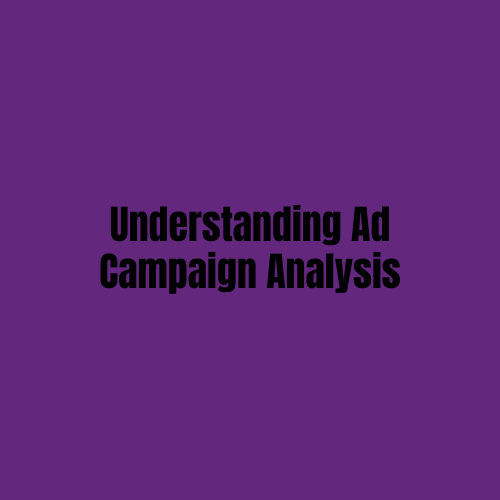Being a Campaign Manager is not about launching ad campaign, is not about setting a target audience or budgets either. It's a meticulous process that involves strategic thinking, planning, predicting.
However, the real magic happens after the campaign goes live: in the analysis. Analysing ad campaigns is crucial for business success, and here's why it should be at the forefront of every marketer's strategy.
1. Maximising ROI: The Financial Edge
Every dollar spent on advertising is an investment, and like any investment, it demands a return. Ad campaign analysis helps businesses understand the effectiveness of their spend. By scrutinising metrics such as Cost Per Click (CPC), Cost Per Acquisition (CPA), and Return on Ad Spend (ROAS), marketers can identify which ads are yielding the highest returns and which ones need adjustments. This level of financial insight ensures that budgets are allocated to the most profitable campaigns, thereby maximising ROI.
2. Audience Insights: Understanding Your Customers Better
One of the most valuable assets a business can have is deep knowledge about its customers. Ad campaign analysis provides granular insights into audience behaviour and preferences. By examining data such as demographics, geographic locations, and engagement patterns, businesses can tailor their messaging to better meet the needs and desires of their target audience. This not only enhances the effectiveness of current campaigns but also informs future marketing strategies, fostering a more personalised customer experience.
3. Improving Campaign Performance: A Path to Optimisation
No ad campaign is perfect out of the gate. Continuous improvement is the name of the game. Analysis allows marketers to pinpoint what’s working and what’s not. For instance, A/B testing results can reveal which headlines, images, or calls-to-action (CTAs) resonate most with the audience. By iterating on these insights, businesses can refine their campaigns to boost performance over time. This iterative process is essential for staying ahead of the competition and maintaining relevance in a constantly evolving market.
4. Identifying Market Trends: Staying Ahead of the Curve
The digital landscape is dynamic, with trends shifting rapidly. Through thorough ad campaign analysis, businesses can spot emerging trends early. For example, a spike in engagement from a particular demographic might indicate a new market opportunity. By leveraging these insights, companies can adapt their strategies proactively rather than reactively, ensuring they remain leaders rather than followers in their industry.
5. Competitor Benchmarking: Gaining a Competitive Edge
Understanding how your campaigns stack up against the competition is crucial. Ad campaign analysis allows businesses to benchmark their performance against industry standards and competitors. By identifying gaps and opportunities, marketers can adjust their strategies to gain a competitive edge. Whether it’s through improved targeting, better creative assets, or more efficient spending, staying ahead of the competition is often the difference between success and failure.
6. Enhancing Customer Engagement: Building Stronger Relationships
At its core, advertising is about building relationships with customers. Analysing ad campaigns helps businesses understand how their audience is interacting with their ads. Metrics such as click-through rates (CTR), conversion rates, and social media engagement provide a clear picture of how well an ad is resonating with the audience. By focusing on these metrics, businesses can craft more engaging content that fosters stronger connections with their customers, leading to increased loyalty and long-term success.
7. Reducing Wastage: Efficient Use of Resources
Inefficient ad spending is a common pitfall. Without proper analysis, businesses can waste significant resources on underperforming ads. Campaign analysis helps identify these inefficiencies, allowing for better allocation of resources. By cutting down on wasted spend and focusing on high-performing areas, businesses can achieve more with less, optimising their advertising efforts for maximum efficiency.
Conclusion
In the fast-paced world of digital marketing, the importance of ad campaign analysis cannot be overstated. It’s not just a nice-to-have but a critical component of any successful marketing strategy. From maximising ROI and understanding your audience to optimising performance and staying ahead of trends, the insights gained from thorough ad campaign analysis empower businesses to make data-driven decisions that drive growth and success.
For marketers who already know how to launch campaigns and perform basic analysis, diving deeper into the nuances of campaign analytics will elevate their strategies and deliver substantial benefits in their everyday work. Embrace the power of analysis and watch your ad campaigns transform from good to extraordinary.
However, the real magic happens after the campaign goes live: in the analysis. Analysing ad campaigns is crucial for business success, and here's why it should be at the forefront of every marketer's strategy.
1. Maximising ROI: The Financial Edge
Every dollar spent on advertising is an investment, and like any investment, it demands a return. Ad campaign analysis helps businesses understand the effectiveness of their spend. By scrutinising metrics such as Cost Per Click (CPC), Cost Per Acquisition (CPA), and Return on Ad Spend (ROAS), marketers can identify which ads are yielding the highest returns and which ones need adjustments. This level of financial insight ensures that budgets are allocated to the most profitable campaigns, thereby maximising ROI.
2. Audience Insights: Understanding Your Customers Better
One of the most valuable assets a business can have is deep knowledge about its customers. Ad campaign analysis provides granular insights into audience behaviour and preferences. By examining data such as demographics, geographic locations, and engagement patterns, businesses can tailor their messaging to better meet the needs and desires of their target audience. This not only enhances the effectiveness of current campaigns but also informs future marketing strategies, fostering a more personalised customer experience.
3. Improving Campaign Performance: A Path to Optimisation
No ad campaign is perfect out of the gate. Continuous improvement is the name of the game. Analysis allows marketers to pinpoint what’s working and what’s not. For instance, A/B testing results can reveal which headlines, images, or calls-to-action (CTAs) resonate most with the audience. By iterating on these insights, businesses can refine their campaigns to boost performance over time. This iterative process is essential for staying ahead of the competition and maintaining relevance in a constantly evolving market.
4. Identifying Market Trends: Staying Ahead of the Curve
The digital landscape is dynamic, with trends shifting rapidly. Through thorough ad campaign analysis, businesses can spot emerging trends early. For example, a spike in engagement from a particular demographic might indicate a new market opportunity. By leveraging these insights, companies can adapt their strategies proactively rather than reactively, ensuring they remain leaders rather than followers in their industry.
5. Competitor Benchmarking: Gaining a Competitive Edge
Understanding how your campaigns stack up against the competition is crucial. Ad campaign analysis allows businesses to benchmark their performance against industry standards and competitors. By identifying gaps and opportunities, marketers can adjust their strategies to gain a competitive edge. Whether it’s through improved targeting, better creative assets, or more efficient spending, staying ahead of the competition is often the difference between success and failure.
6. Enhancing Customer Engagement: Building Stronger Relationships
At its core, advertising is about building relationships with customers. Analysing ad campaigns helps businesses understand how their audience is interacting with their ads. Metrics such as click-through rates (CTR), conversion rates, and social media engagement provide a clear picture of how well an ad is resonating with the audience. By focusing on these metrics, businesses can craft more engaging content that fosters stronger connections with their customers, leading to increased loyalty and long-term success.
7. Reducing Wastage: Efficient Use of Resources
Inefficient ad spending is a common pitfall. Without proper analysis, businesses can waste significant resources on underperforming ads. Campaign analysis helps identify these inefficiencies, allowing for better allocation of resources. By cutting down on wasted spend and focusing on high-performing areas, businesses can achieve more with less, optimising their advertising efforts for maximum efficiency.
Conclusion
In the fast-paced world of digital marketing, the importance of ad campaign analysis cannot be overstated. It’s not just a nice-to-have but a critical component of any successful marketing strategy. From maximising ROI and understanding your audience to optimising performance and staying ahead of trends, the insights gained from thorough ad campaign analysis empower businesses to make data-driven decisions that drive growth and success.
For marketers who already know how to launch campaigns and perform basic analysis, diving deeper into the nuances of campaign analytics will elevate their strategies and deliver substantial benefits in their everyday work. Embrace the power of analysis and watch your ad campaigns transform from good to extraordinary.



